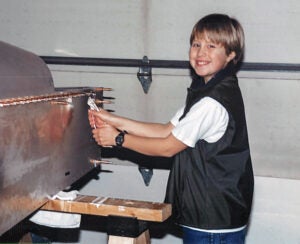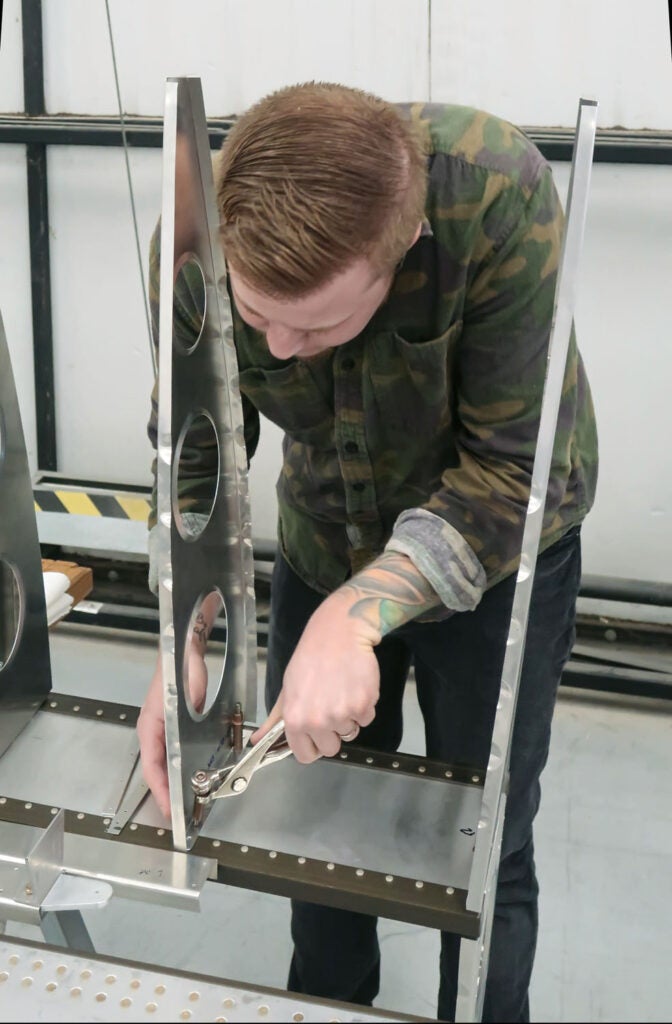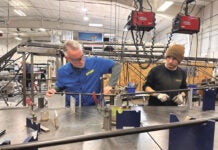This topic came to me in a dream, probably triggered by a New Year’s Eve chili-and-pumpkin pie-eating binge. Still, it’s rooted in reality, and it had me wide awake, heart racing, 195 minutes into the new year. I dreamed I was helping put wings on an airplane. The request was simple enough, “Kerry, can you hold the wingtip?” Of course I can. I am a people pleaser. There is no yes too great or too small. But in short order, I was on the receiving end of harsh directives and glances that questioned my intelligence.
“Wiggle it!”
“No! Forward and backward, not up and down!”
“That’s too much! Now I lost the hole!”
“Lift it!”
“No! Lift the trailing edge, not the wingtip!”
I blamed myself, as is my way, for not knowing exactly what was expected of me. How quickly my agreement to help left me battered against the rocks of self-doubt. How quickly I wanted to stop being a helper. I extracted myself from the situation by waking myself up. (I’ve gotten good at that.) My chest was tight, my breathing shallow. And it was only a dream.

The Helped and the Helper
I maintain that, if necessary, I could have built my airplane without any help. But sometimes, the help of a neighbor, friend or offspring with small hands kept things moving along and brought a bit of socialization into a solitary activity. Whenever I needed help, I tried to clearly communicate the goal, the process and my help’s specific role in the task. I didn’t want them to feel unprepared or intimidated. Or worse, I didn’t want them to hide their feeling of being unprepared from me. There’s no point in asking someone for help and not equipping them to help.
I’ve also been a helper. I helped a friend rebuild portions of two certified aircraft. I was usually inside a hollowed-out fuselage pressing a bucking bar against the tail of a rivet, or elbows-deep under a partially riveted wing skin groping for a rivet tail I couldn’t see. It was fun, social (between burps from the pneumatic riveter) and rewarding.
“Ready?”
“Hit it!”
Brap. Brap.
“Good!”
It was my job to help him achieve the desired outcome, and it was his job to assure I knew what the desired outcome was. That required his understanding that I can’t read minds and my understanding that I needed to speak up if I wasn’t clear on the goal.

Teaching Tips
Your helper may not have aircraft building knowledge. Take them under your wing, so to speak, and teach them the skills they’ll need. Train your help in a manner that suits them, not you. Everyone learns at a different pace and in a different way. I can draw from several negative personal experiences that all share the same training error; the person training me never gave me the opportunity to learn and practice the skill. At the first sign I was about to do something they deemed wrong—for instance, my method of spreading mayonnaise on a fast-food hamburger bun—the tools were snatched from me and the job was completed while I watched. I wasn’t given a chance to develop my own technique or the time to duplicate theirs. Some people—me—don’t do well while being watched. (I even struggle to record guitar riffs while playing alone in my living room because I know the microphone is watching.) I need time, unwatched, to develop a skill. Give your helper the encouragement and time (if necessary, solo time) to become comfortable with the skill you’ve asked them to perform.
My middle school math teacher is memorable for two reasons: He slurred the phrase “the set whose members are” into something I couldn’t comprehend or find in the textbook, dooming my grade for that unit. And he taught us that if you know why, the how can reveal itself—a more understandable derivative of Nietzsche’s “If you know the why, you can live any how.” Aircraft construction is filled with “whys.” Why are parts de-burred? Why do we select a certain bolt length? Why are castle nuts used sometimes? Why are mating holes match-drilled? Why don’t we use Teflon tape on oil and fuel fittings? (The answers, the hows, we call best practices.) When you educate your help on why something is or isn’t done, they can transfer the how to similar scenarios.
A Thought on Group Projects
Group projects have no helpers, they have participants. That is an important distinction. A group project needs a project manager to manage the tasks, talent, timeline and budget, but not to lord over the members of the group. Homebuilding is for education and recreation. Group projects should be the epitome of that. When that focus is lost, so will be the members of the group. The personality of each member should be matched to a project’s tasks. One member may thrive turning marine-grade plywood into hundreds of rib gussets, while another may be bored by repetition and want to build the vertical stabilizer, completing all the tasks that that entails by herself. Happy participants will create a fun work atmosphere and produce quality work. Shouldn’t that be the point of the project?
Beyond the occasional need for help, which will surely arise, you may want to share the homebuilding experience with someone: your spouse, your kids or grandkids, a sibling, a friend. It is up to you to make the partnership rewarding. Helpers deserve your patience and clear guidance. You become an ambassador to homebuilding when you enlist someone’s help. Represent our activity well. It’s better to inspire the next builder, or pilot, or both than ruin a relationship. When you find yourself needing to be on both sides of a firewall at once, you’ll get by with a little help from your friends.














I loved working on cars as a kid. I did it for 5 years before I got my own car to drive and work on. Helping others has usually helped me more in the end. I learned so much. The same was true with everything else I’ve done in life.